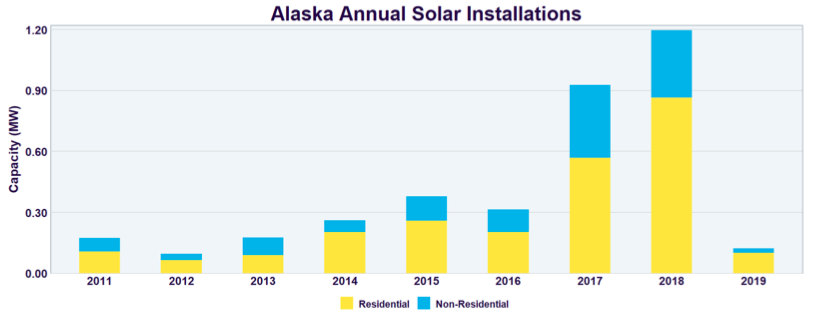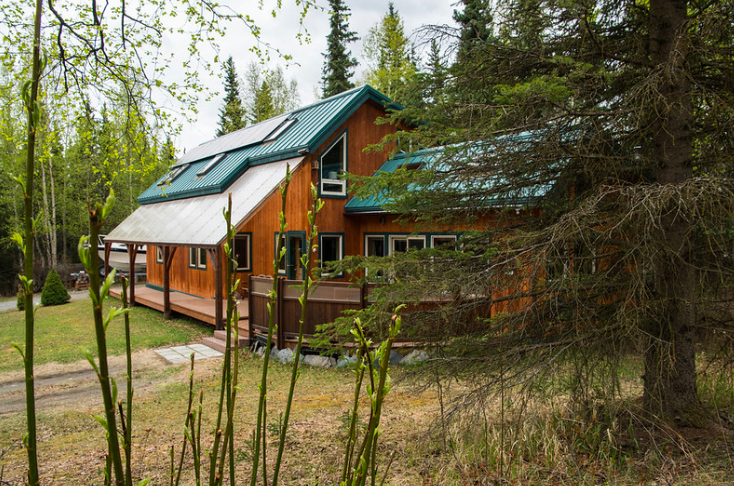“Happy Summer Solstice” is the greeting of the day. Are we harnessing the power of the midnight sun? Not so much.
The 49th state may be almost dead last in the use of solar power (thank you, North Dakota for sparing us the embarrassment), but according to the Solar Energy Industries Association, Alaskans are starting to adopt this next-generation energy source.
As of the first quarter of 2019, there are 3.6 megawatts of solar power being used in Alaska, enough to power 410 homes. Nearly half of that capacity was installed in 2018, and most of it is residential. This chart shows the growth, through the first quarter of 2019:

Alaska has 14 solar energy companies total: 0 manufacturers, 8 installers, and 6 others, according to the trade organization, which says the total solar investment in the state is nearly $11 million. Prices for solar energy have dropped 34 percent over the past five years, which likely accounts for the growth in solar energy additions to homes and businesses.
Some villages and rural hubs are now installing solar panels. Take the Native Village of Hughes, which just installed the framework for a 120-kilowatt solar photovoltaic system that will cut diesel use and costs while advancing the village’s renewable energy goal of 50 percent by 2025.
Once the system is integrated with the local power system, this community of 110 people on the Koyukuk River, some 210 air miles north of Fairbanks, will boast rural Alaska’s largest solar project.
[Read more about the Hughes solar project here.]
There are now over 660 solar installations in Alaska and 66 solar jobs, according to SEIA.org.
Of course, the use of solar energy still only comprises 0.04 percent of the energy used in our oil-consuming state. But in the north, whenever there’s more than 12 hours of daylight, that’s enough solar potential to power a home for half a day.
The problem is, it takes years to recover the savings from an installation, so most people who are installing solar cells are doing it for other reasons than cost savings. Maybe they live off the grid, or maybe they are early adopters of new technologies, but they’re making a big investment they might not recover in their lifetime.
A solar system in many parts of Alaska will actually produce more energy than the home consumes from April through September, according to the University of Alaska Fairbanks, which has a complete study of Alaska solar energy design practices here.
Read more about Alaska’s solar energy profile at the Solar Foundation.
Do you have a solar installation? Is your village or rural community installing solar panels? How is it working for you? Leave your comments below.

If the environmentalists and government want us to install more solar then why don’t they subsidize the costs greater then it is now. You get some sort of tax writes off but the costs are never fully recovered in one’s life. But, they (Government) give lots of money to solar companies and other large organizations that now have gone bankrupt, but nothing for the average homeowner. Go figure.
Agree with everything but “The problem is, it takes years to recover the savings from an installation, so most people who are installing solar cells are doing it for other reasons than cost savings. Maybe they live off the grid, or maybe they are early adopters of new technologies, but they’re making a big investment they might not recover in their lifetime.”
Because of our high energy costs, Alaska has a relatively short payback period in the range of, 5-10 years. Hopefully y’all will live longer than that 😉 “https://www.solarpowerrocks.com/infographics/solar-infographic-state-solar-investment-returns/
We did a 32 panel system for a lady who had a huge bill every month. $700 range. When we turned it on her bill went to $40 the next month (Sept). Her payback period was going to be less than 7 years.
Whatever happened to Solyndra? They got $528,000,000 is subsidies from the government for their solar panel plant.
How about Solar City? Their business plan was to “strategically aligning our products with key government programs that provide financial incentives, export credit and project finance”
What? The government solar subsidy gravy train dried up after the Democrats left the White House?
What about the little guy? Just think what Alaskan homeowners could have done with all those government solar bucks!
And the folks that are installing the solar panels are delusional if they thing that such actions reduce the carbon footprint and are somehow good for the environment. Production of the panels is very energy- intensive and requires lots of metal. Much – but certainly not all – of our legacy energy infrastructure was developed because it was the most efficient and effective way to power our lives. There is room for improvement; we should make wise energy choices, not fashionable ones.
Glad to see this topic on MRAK as so much more of our energy can come from renewables in Alaska although there are still financial challenges to maintaining a personal “solar system” on private property for residential use.
The big expense and maintenance is in the batteries used to store the energy collected from the sun.
Another concern is that the most available collected energy is in the summer months when Alaskans use less than ever on average at their homes and cabins. (More time spent at rivers, lakes and the sea)
Then in the winter when folks are around more using heat pumps, hot water and lights…there is less solar power available due to the lack of sunlight.
For these reasons and others, the best step forward is for AK to plan on more smaller grids in communities that share the burden of system costs through a co-op that manages the system.
This allows businesses as well to use the available energy and share the long term costs. (Battery replacement)
Several smaller municipalities on the east coast have been very successful with this financial operating model.
A new commercial solar panel system is currently adding energy to the railbelt grid from Willow this year and hopefully there will be more to follow.
There is also a lot more that can be done harnessing the wind in Alaska but renewable energy does not have an “SB 21” to stimulate investment in AK.
I run a Solar business up here in Wasilla. I got my start by purchasing a system for my off grid place I built in 2011 when I retired from the Army. This turned into setting systems up for friends and neighbors and eventually opening a business. My place is 2 miles from the nearest power. I run 6 solar panels, a 4,000 watt inverter, and 8 batteries tied into a generator with an auto start. My batteries will run my place (Well pump, fridge, chest freezer, toyo stove, tv, computer, microwave and whatever else I am running for about 24 hours with no sunlight. Then my generator runs for 2 hours to top the batteries off using a gallon of gas. My Generator has not run for a month and a half and probably will not for another month or two. The cost for this system was about $15,000. The cost for MEA to connect me? Probably over 100k. Solar can definitely be worth the cost.
Upfront costs appear to have certain negative effects on the environment when initially installing, but if the materials can last long they can benefit and save energy in the long run!